
14 minute read
Western Region Passenger Rolling Stock (or not...)
By 1980 I was ensconced in the WR General Manager’s Passenger Rolling Stock department office at Paddington. Open its door to the corridor outside and the complete vista of the platforms and train-shed interior of Paddington were laid out before and below you as we were situated to the side of Platform 1� A downside of all this was that your, erm, cock-ups, could be clearly seen, as a train with the wrong coaches might sit in full view of the General Manager, who occupied offices only two doors down from ours.
My job was to endeavour to ensure that all loco-hauled passenger trains consisted of the correct vehicles, preferably in the right order� We were encouraged to actually go down to the platforms to check on the results of our work and occasionally we were able to experience special trains when they were in one or other of the platforms� In this book you can see the result of that with the Cheltenham Gold Cup special of Orient Express Pullmans although once, with great fanfare, the prototype diesel-powered four-car semi-fast DMU arrived for inspection. In effect it was a 317 or South Western suburban unit, but not powered by electricity. Someone remarked it looked like an early 1900s Manchester to Bury electric unit! We were not impressed. Another time a panic-stricken Passenger Inspector burst in to say that the Queen Mother was on the late morning arrival from Cheltenham and there was no-one to meet her� I am not certain whether she was impressed with my hastily combed hair and tweed jacket, but we got her into her car without too much hassle �
Advertisement
Luckily for me the air-braked Mark 2 sets which provided the lion’s share of the stock for the West Country/Bristol/South Wales services virtually ran themselves and I don’t recall any serious hiccups� I was backed up by fabulous guys at Old Oak Common, Laira and Malago Vale, Bristol, the Foremen of which I spoke to every morning first thing and they reported a complete run down of every passenger vehicle at their location and its status. No computers then, I had to handwrite a report-sheet each day�
The list was vital. If anything in the London Division went tick, you could usually work something out with OOC. The worst occasions were the aforementioned Mark 2D FO with no seats and when, for some reason or other, there seemed to be a defect pandemic breaking out amongst the Sleeping Cars (SLEPs). I remembered in the back of my mind that for week after week Laira reported two ‘spare’ SLEPs, but nobody took much notice until it seemed that there was a UK shortage of them, at least two went tick at the same time �
Sleepers were like Catering Vehicles, we existed on just enough and not more� The latter were continually unavailable at critical moments because Traveller’s Fare wanted to restock or destock or some such nuisance activity� That meant OOC would have to extract the vehicle they wanted from the set it was in, then you had to arrange a trip to bring it to the parcels bay outside the station itself at the end of Platform 1 where the first WR publicity shot of desert-sand Western Diesel Hydraulic D1000 was taken. All so that the passengers could be nourished en route.
So, one day to try and alleviate the SLEP shortage I had the bright idea of retrieving those vehicles from Laira � We ran a daily Empty Coaching Stock (ECS) and parcels train from Plymouth via Bristol that picked up and dropped off anything we at Paddington asked it to, in addition to its normal everyday consist. When the two sleepers arrived at OOC, the shunters were surprised that they contained, from floor to ceiling, spare and used bunks, bedding and anything connected� It took some time for the ever-dependable staff there to sort them out and make them useable � Another oops moment �
The Cardiff/Portsmouth axis Mark 1 stock situation wobbled from on the brink to a shambles whatever you did, not helped by the fact that Malago Vale sidings were not the easiest of locations to sort stock out in� This was mainly because of its layout, not the staff� Talking of Mark 1s, there would be an almighty rush every Friday to allocate sets to weekend specials and summer timetabled holiday workings. For instance, all the London Division commuter sets had work diagrammed for them, anything from Blackpool Lights excursions to Merrymakers, after their last commuters alighted at Oxford, Didcot or Newbury on a Friday evening. There were many lively discussions at about 17.00pm with Control, who were trying to find locos and men to work them to other regions and retrieve them back on Sunday nights ready to take up where they left off� Occasionally on a Monday morning there would be a tale of woe as an excursion returning to the Eastern Region had stood at Acton Wells Junction for over an hour as a replacement guard had been missed off the incredibly complex temporary weekend re-diagramming�
And so we rolled on, from day to day, ensuring we had plenty of time for relaxation� A non-stop trip to Taunton on the Golden Hind and back one evening after work for beer and checking time-keeping was not unusual whilst being the only passenger on a seven-coach overnight test of Mark 3 Sleepers was plain weird, but all part of the job�
Old Oak Common
Transmission transition
By the time British Rail had rid itself of its last main-line hydraulic transmission locomotive, it had been less than 20 years since the first so-equipped machine had taken to the UK’s rails� Indeed, the second class to be introduced with this means of propulsion, the Bo-Bo Warships, had enjoyed little more than ten years on the rails compared to upwards of 30-35 years for the locos they were supposed to replace � Why was that?
In the main it was petty internal British Railway Board (BRB) politics, coupled to an obsession with standardisation and a measure of help from the inevitable accountants but, however much I and thousands of fellow enthusiasts loved those locos, it has to be admitted that their introduction was partially a bit of Great Western Region one-upmanship�
But this one-upmanship had actually been well-researched before any decisions were made regarding what became known as the Warships� At the time, it was the case that the most prolific users of diesels with hydraulic transmissions was Germany and in their V200 class they were proving that the system had huge weight advantages over those with electric end-power, the latter types being pushed by US constructors such as General Motors and Alco� This was because those German units utilised a torque-converter to transmit the power from engine to the wheels, thus enabling much heavy equipment to be eliminated. At the time of the introduction of the Bo-Bo D8XX series of locos, BR’s mainstay express mainline diesels, which became the Class 40s and 45s, were weighing in at around a hefty 145 tons each, whilst the Warships were only 80 tons apiece with the same power output � That’s the equivalent of two extra coaches’ trainload or better hill climbing, a factor important to the WR in Devon and Cornwall. Another advantage of the WR locos was the use of high-speed diesel engines which allowed smoother pick-up and better acceleration, as revs equals power.
Initially some fabulous performances were produced by the D8XXs, with more than one 100mph maximum recorded on an up Bristolian one day, but due to the high centre of gravity of the class, as the power unit was mounted high in the frame, bogies were subject to excessive lateral loadings and until this problem was fixed an 80mph limit was placed on them by the Civil Engineer. The V200 class in Germany, upon which the Warships were closely based, were wider and too big for the BR loading gauge, so the engines were mounted higher in the UK versions to allow other equipment to be fitted underneath, thus allowing the bodies to be narrower�
The WR continued to place full reliance on the hydraulic system with the introduction of 1100hp Bo-Bo’s, 2700hp Co-Co’s and 1750hp Hymek Bo-Bo’s� The latter two classes proved popular and successful, but the North British built D63XX early 1100hp class was not so lucky, although it wasn’t the transmissions which caused their early demise �
Eventually Brush Traction and its Type 4 Class 47 provided the BRB with what it thought it wanted as a standardised main-line class and their accountants won the day, forcing the WR to toe the line, but it had been a fascinating period which was enjoyed by many steam enthusiasts, who realised that diesels need not be entirely devoid of character and amusement �
The elimination of steam from the WR and BR meant engine shed demolition could take place and Old Oak Common – 81A – was no exception. Here a group of working locos are parked around what was, by 1970, all that was left of the original roundhouse sheds. Hymeks D7071 and D7019, Class 42 Warship 821 ‘Greyhound’, Class 31 5535 (later 31117) and Class 47 1639 can be identified amongst the locos present.The Class 47 is still with us, having been renumbered 47055, the locomotive was fitted with ETH and became 47652, then 47807 operated by Virgin Trains. It was then chosen to be re-engined as part of the Virgin Thunderbird Class 57s and became 57304. The locomotive is currently operated by Direct Rail Services and is named ‘Pride of Cheshire’. The loco is the only thing that still exists from this photograph�

Imagine this turntable scene at Old Oak Common with an all-over roof covering it and then multiply that by four� That would have been the size of the original roofed stabling area of the shed. In the left background is the repair and maintenance building colloquially known as the ‘Factory’. The shed with the clock is more recent and for fuelling and there are 16 locomotives gathered around the turntable, including four Western Class 52s, two Warships Class 42, five Hymek Class 35s, two Brush Type 2 Class 31s and three Brush Type 4 Class 47s at rest, and clearly, most have their engines running�

The Western Class 52s were such handsome locomotives and these two (D1038 ‘Western Sovereign’ on the left) are gathered around the last-remaining turntable at Old Oak Common motive power depot along with a couple of duo-green Brush Type 4 Class 47s (D1747, later 47154/47546, is on the right) in 1971. It was somewhat bizarre that a steam-age piece of equipment should still be needed in diesel days. This turntable was one of four at Old Oak originally laid out in a rectangle and all would have been inside a single vast building providing covered accommodation for many of OOC’s top-link Kings, Castles, Halls and the nocturnal night-owls, the 47xx 2-8-0s, during the day plus all the locally allocated pannier tanks. Demolition of OOC began in March 1964 prior to all steam locos being moved away to Southall early in 1965� This is all that was left some 6-7 years later but the depot still remained open�
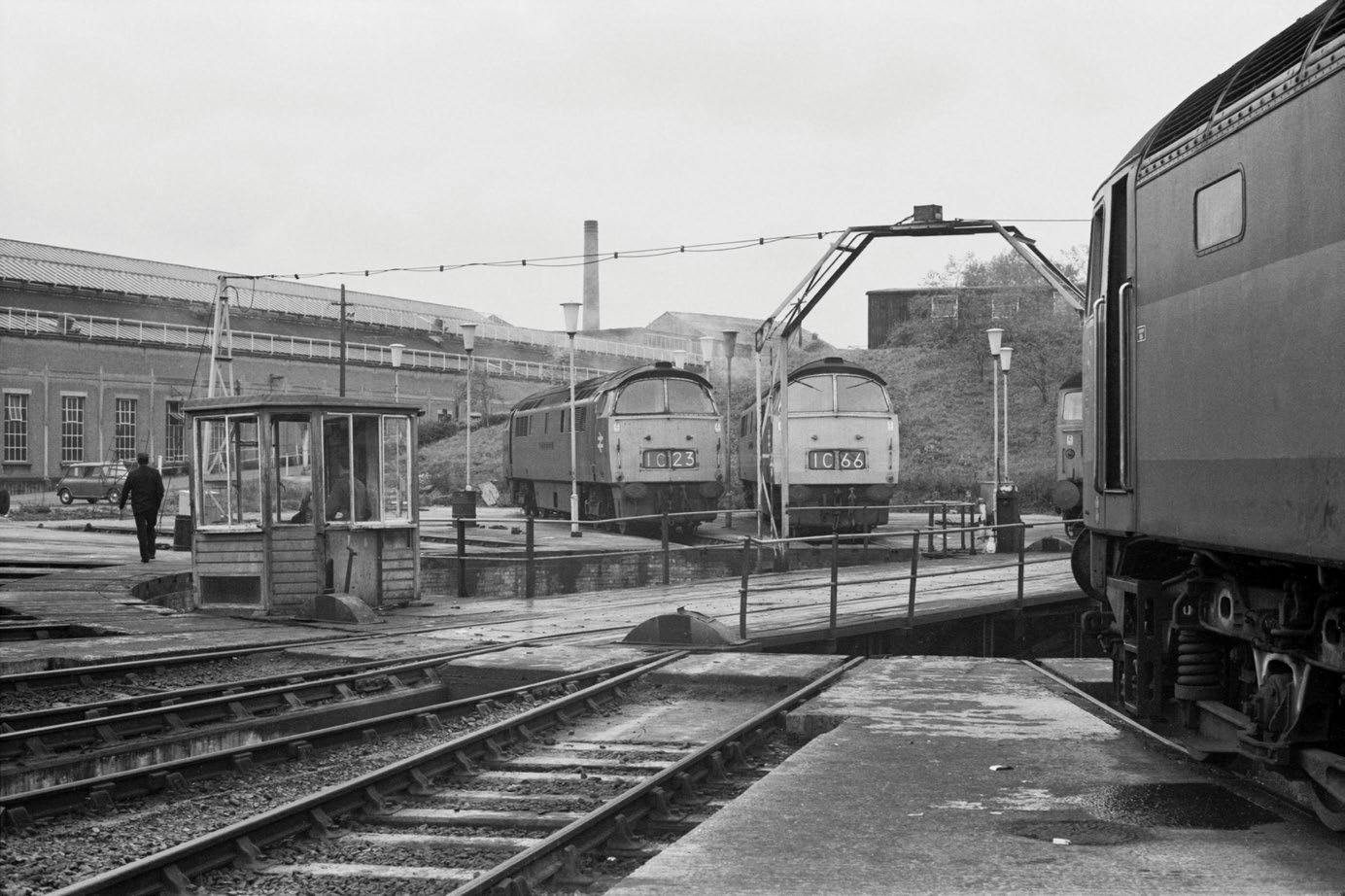
Old Oak Common turntable in 1971 and the accident-damaged front corner of a down-at-heel Hymek fronts an exceptionally well-kept Warship Class 42 number 821 ‘Greyhound’, later to be adopted by preservationists, whilst a Brush Type 4 Class 47 1639 awaits its next turn of duty in the background. The first Brush Type 4 Class 47s to be allocated to OOC started to arrive during the winter of 1963/4 to take over the Birkenhead services from the Westerns and were thus forced to share the original Churchward quadruple turntable shed with the steam allocation.
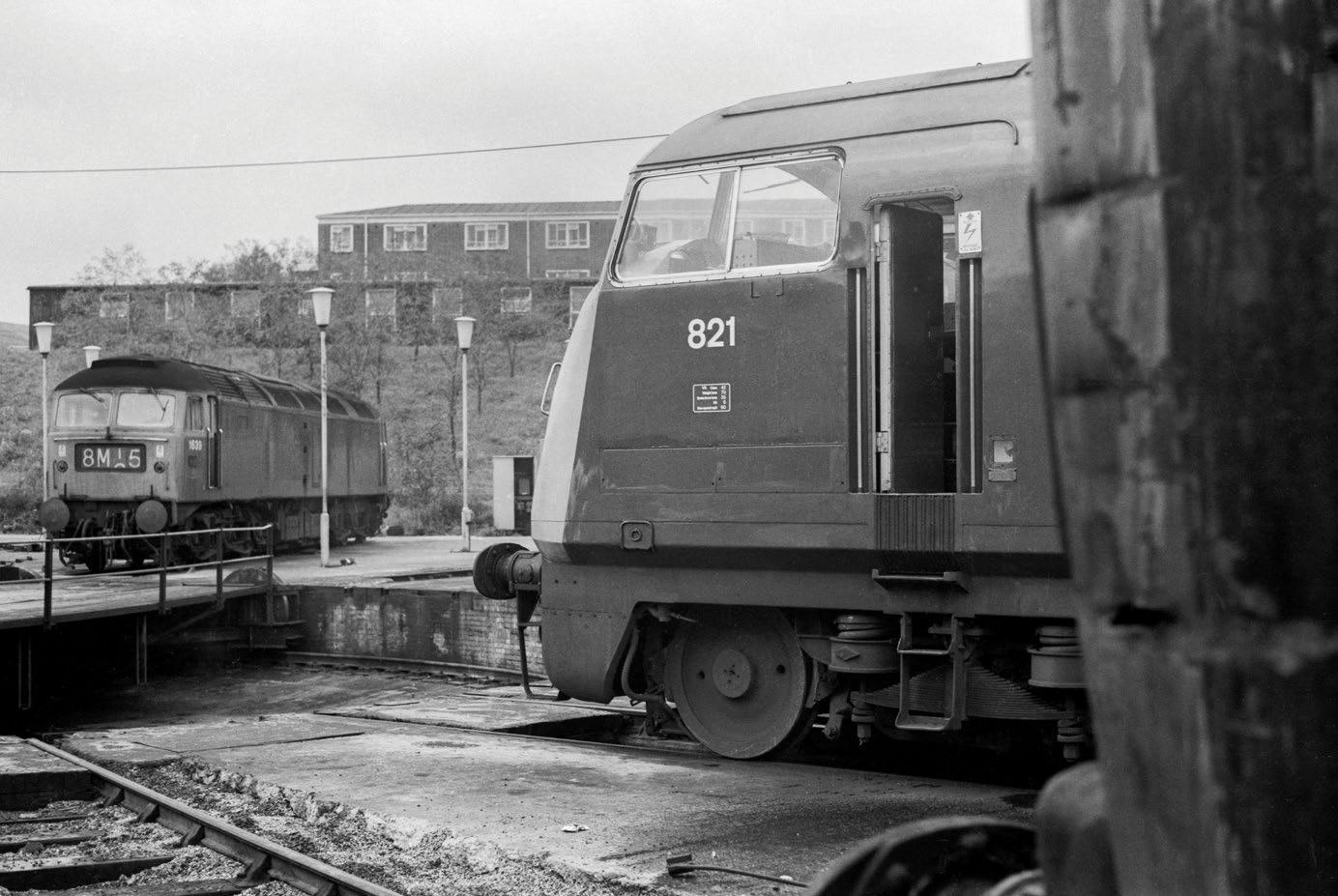
Old Oak Common turntable in 1971 with a Brush Type 4 Class 47 number D1747, (later 47154/47546) on the left in nearly original dual-tone green condition except for full yellow cab-ends. An unkempt Hymek Class 35 number D7049 is on the right and both are facing a Western Class 52 across the table which is of the girder beneath type and would originally have been totally boarded in when there were four of them� The Hymek is only a few months away from withdrawal, it being withdrawn on 1st January 1972�

Original green and very early rail-blue liveries feature in this shot of locomotives at rest outside Old Oak Common ‘Factory’.The Brush Type 4 Class 47 number D1657 (later 47073/47537 and now still operational with West Coast Railways as 47772) is either waiting to go in for repair or has just received an exam and is awaiting return to service. It is in its original livery as applied at Crewe. Stored Hymek Class 35 D7006, one of the first two locomotives of the class withdrawn in September 1971, is very much in early condition with green superstructure and lime-green lower band, with only a small yellow warning panel on the cab front, the windows of which have the original grey painted surround� Left in the open outside on a dead-end siding It would seem that it does not have much more life stretching ahead of it� In contrast, shed pilot 350bhp diesel shunter Class 08 number D4003 (later 08835, then 09015)is in early rail blue with British Rail logo on the cab-side.
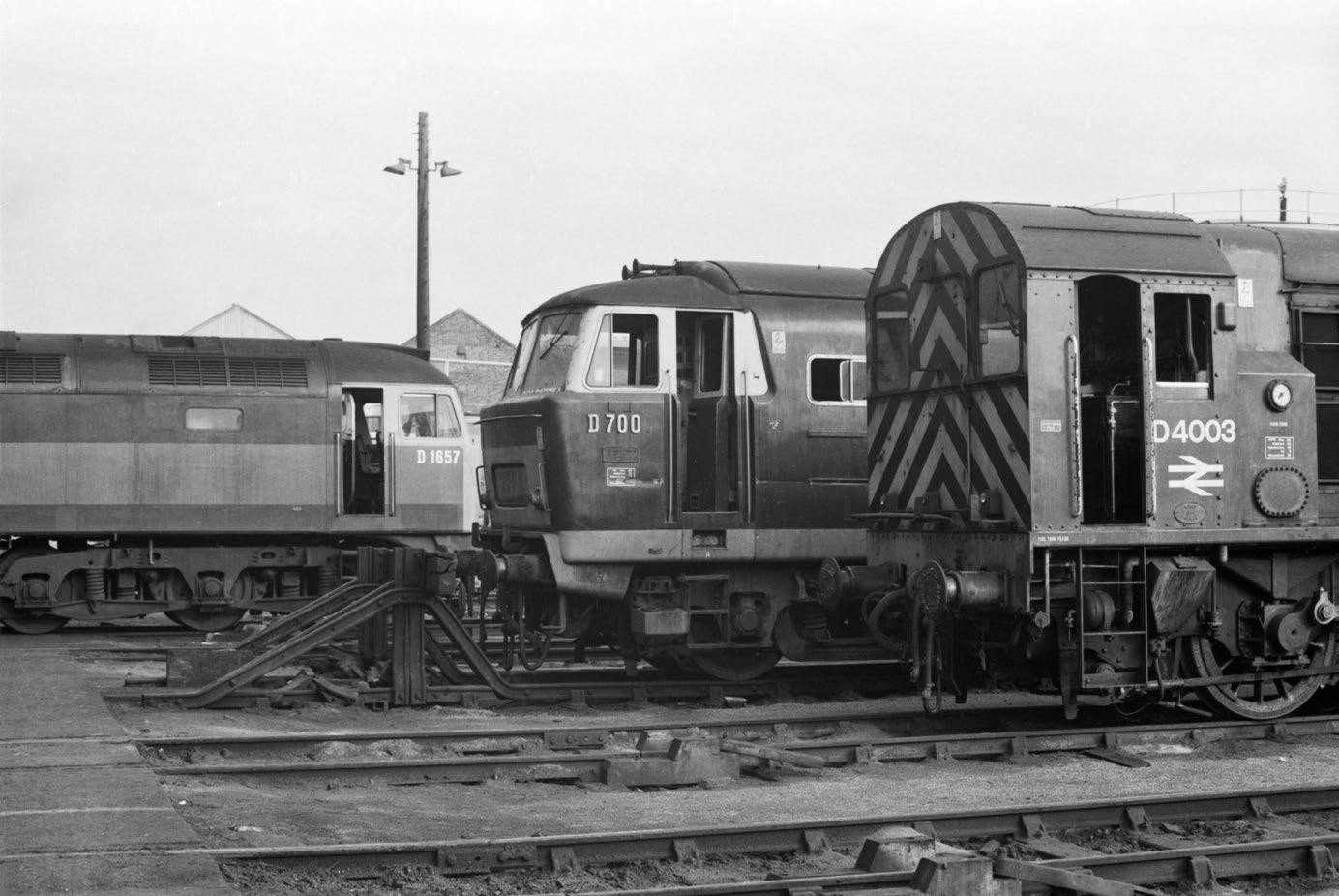
Hymek Class 35 number 7029 is parked outside the Old Oak Common ’Factory’ awaiting repairs� Possibly, it will be the recipient of the spare Hymek power bogie seen in the foreground. The loco also displays one of BR’s crass displays of modernisation at all costs, whereby the cast ‘D’ has been painted out so that everyone would be fooled into thinking what an up to date non-steam railway system it now was� The locomotive is one of four Hymeks that did not suffer the fate of the cutter’s torch� Owned by the Diesel Traction Group, it is currently undergoing a complete restoration at the Severn Valley Railway.

With a Class 08 350hp shunter on the left, Brush Type 4 Class 47 number D1670 (later 47085) ’Mammoth’ is spied at Old Oak undergoing maintenance. The sides of the Type 4 are even adorned with a tribute to Arsenal FC � The nameplates seem to have interested many people as they had a habit of disappearing then being re-applied� The nameplates were retained after the locomotive was re-numbered under the TOPS scheme in February 1974, but went missing some time in 1975� They were replaced in October 1978, but went missing again in 1984 until replaced in February 1985. The nameplates were finally removed when the locomotive was renamed ‘Conidae’ in August 1988! But where are they now?
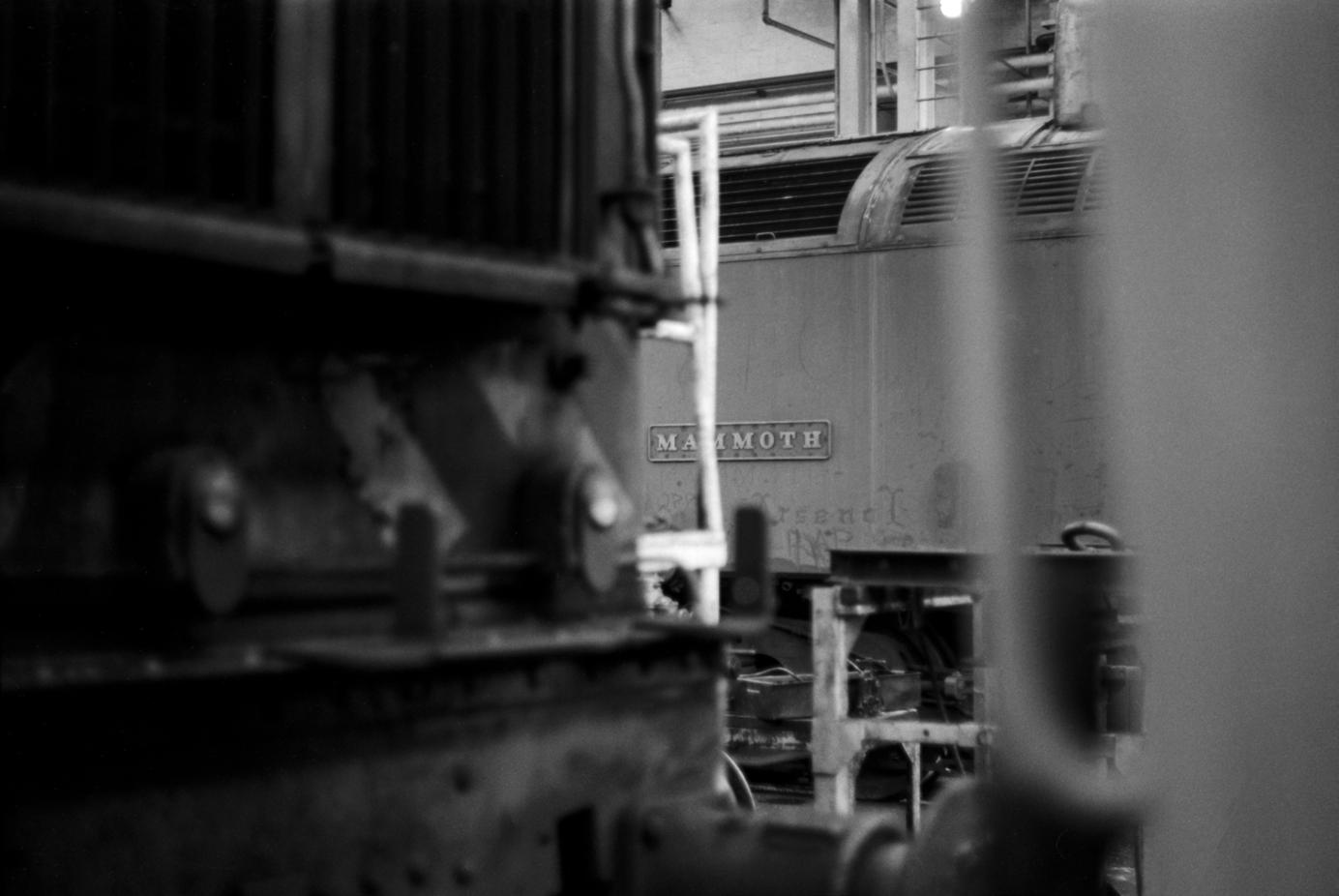
All the GWR ‘A’ code sheds had their own, quite substantial, lifting shops where locomotives requiring more complex repairs than just running and servicing problems, could be accommodated and dealt with. Old Oak Common’s was known colloquially as the ‘Factory’ and this shot was taken inside in 1971. Western Class 52 number D1042 ‘Western Princess’ is in for some work and displays, under its running number, the sticker provided on all locomotives after the end of steam on BR, depicting such information as its maximum speed, brake force and route availability� The loco also displays its shed-code plate, or sticker as the genre had evolved, in this case Laira (84A)�

Old Oak also consisted of extensive rolling-stock stabling sidings and here, amongst the non-passenger stock on display, is a vehicle from the LNER� It is a Gresley BG� Note the porcelain door-handle on the corridor-connection white door and the, by this time rarely seen or used, horse-box at the end of the consist� On the left is a Collett BG used for newspaper traffic, in this case,The Observer.
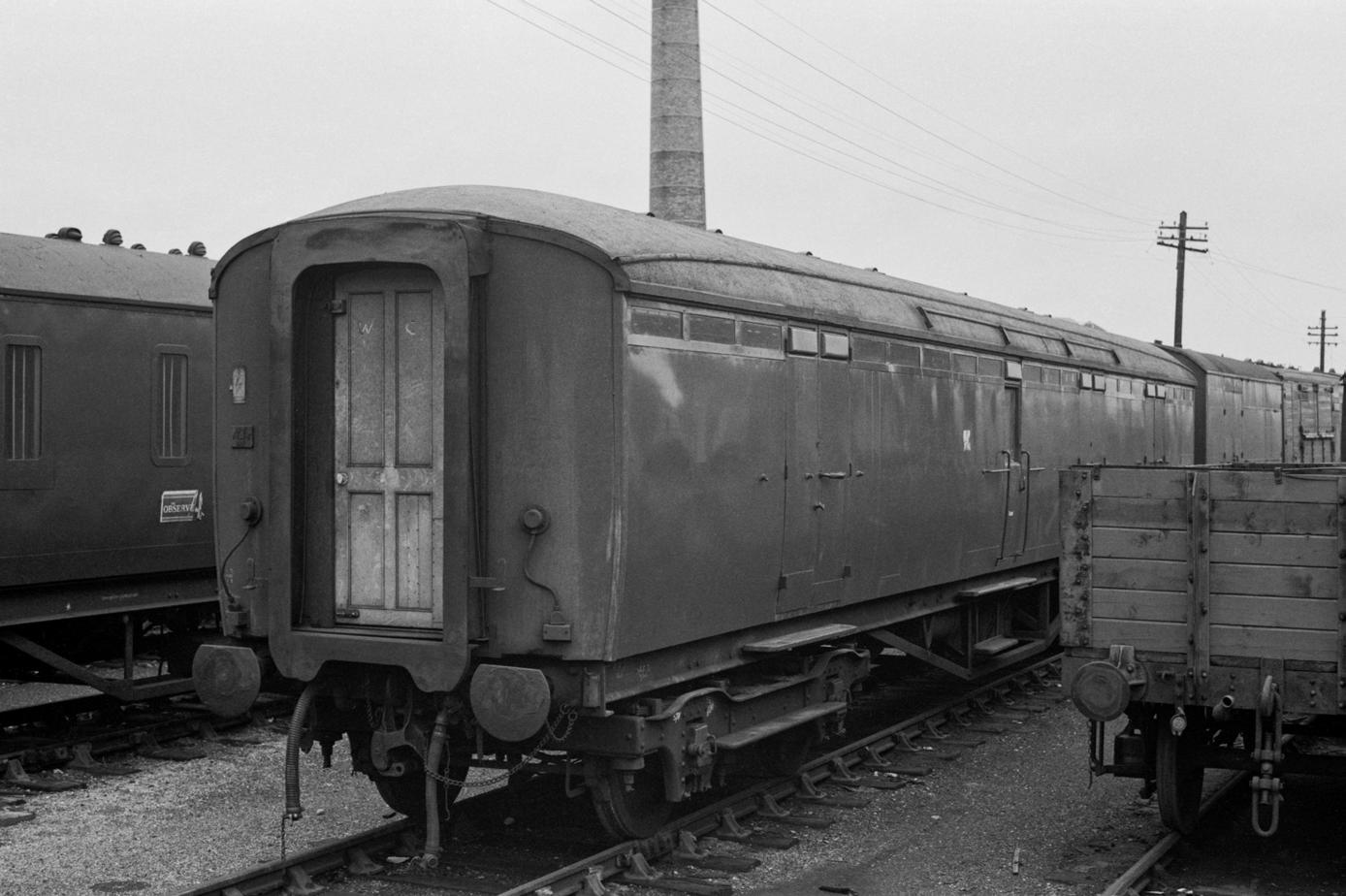


Kensington Olympia basks in the warmth of a beautiful spring day in 1971 as Hymek Class 35 number D7055 rumbles slowly though with an Acton to Norwood Yard transfer freight. There were many of these services scheduled to run inter-regionally across London although, by this time, their future was hanging by a thread as British Rail desperately tried to extricate itself from wagonload traffic. Traffic from the LMR came from Willesden and that from the ER mainly from Temple Mills. Kensington Olympia was yet to be returned to being a station on a national railway network and, as can be seen, no third-rail electricity supply had yet been laid� The first vehicle in the train is one of the ‘To the Continent by Rail’ vans that would be attached to a Dover service once on the Southern and, by means of one of the cross-channel train ferries, gain access to France and beyond for European traffic – the Channel Tunnel was not the start of pan-European rail services.

A quiet moment one summer’s morning at Kensington Olympia in 1971 as a Brush Type 2 Class 31 gets underway from a signal stop outside the North signalbox, with a cross-London freight for Hither Green�
This is a fascinating glimpse during the long evolution of BR from Victorian masterpiece of the world to state-of-the-art modern railway� The signalbox, signals and general infrastructure are firmly from the past and even the locomotive, by this time, is coming up for its 12th birthday, longer on the rails than many of BR’s Standard classes of steam engine managed� Mind you, the budget available for change from the public purse was tiny, compared to the huge amounts thrown at today’s privatised rail franchises�

Still carrying its duo-green livery and ticking over in the languid way that typified the type, Class 25 Sulzer Type 2 number D7530 (later 25180), one of the late-built batch, sits in the warm sunshine in 1971 in the Milk Sidings at London’s Kensington Olympia station, surrounded by an array of LMS style upper quadrant semaphore signals.
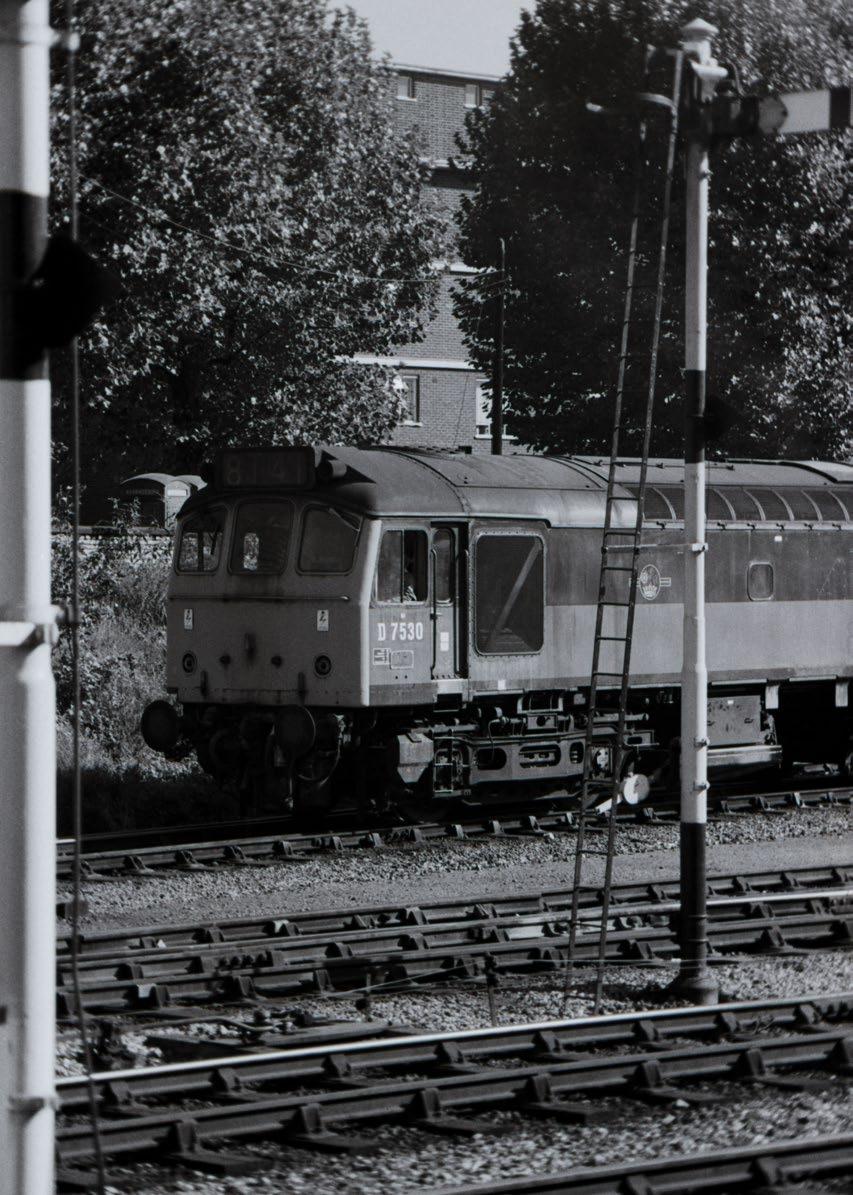
The station was originally named Addison Road after the street in the background but was changed when the Olympia exhibition halls were built alongside �
Eventually the route was electrified on the DC third-rail system which led to the development of London’s Overground suburban lines, but also allowed Eurostar trains to travel from their Old Oak Common depot to and from Waterloo International until that service was found a permanent UK home at St Pancras, with maintenance at Temple Mills�
Just being given the road is a Southern Crompton Type 3 Class 33 number 6577 (later 33058) with an inter-regional Coal Concentration train, probably from Chessington to Brent on the LMR� The location is Kensington Olympia where all the regions, except the Scottish, met in some form or other� Although the signalling is firmly from the pre-war era, the modern world is represented not only by the Class 33, but also by a Class 08 350hp shunter acting as station pilot to shunt the milk terminal, and a Mark 3 Ford Cortina�

Another late-model
Class of built rumbles through Kensington with 9T37, loose-coupled inter-regional southbound coal, probably from the Midland’s Brent Yard in North London. Brave new world, but even that headcode box would prove to be transitory� It was astonishing how busy the line was with freights following each other in both directions� Now it’s almost entirely Class 378 Overground trains which run every 20 minutes in both directions between Clapham Junction, Willesden Junction and beyond. The locomotive was one of twelve ‘low-hours’ (since overhaul) of the remaining Class 25/3 locomotives that were subsequently designated as Class 25/9 in March 1985. Intended to operate traffic expected to be won for the Industrial Minerals Division of Railfreight, it was withdrawn soon after when Railfreight failed to win the contract.

One day the Special Carriage Notices landed on my desk and foremost was a very small item� It consisted of only three lines of print� The Royal Train was due to arrive at Kensington Olympia that Sunday in the early afternoon. In theory it had nothing to do with us as the train was due onto the WR at North Pole, run briefly to Kensington, where the locos would run round, and it would then depart northwards again� One big attraction was that this was not the latest Royal Train, but the previous incarnation, thus it contained such gems as the 12-wheeled converted ex-LNWR power car, which can clearly be seen as the first vehicle behind the two Sulzer Type 2 Class 25s� Other than the railway employee on my platform and the member of the public in the right background, there was no-one else around to record the movement�











